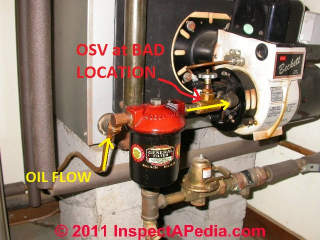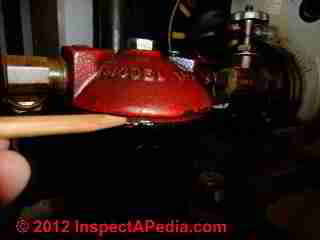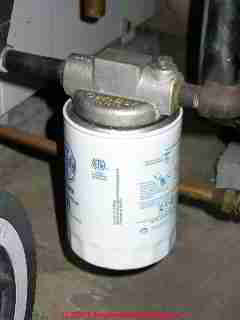 Guide to Oil Filters on Oil-Fired Heating Equipment
Guide to Oil Filters on Oil-Fired Heating Equipment
- POST a QUESTION or COMMENT about installing, servicing, and repairing oil filters used on oil-fired heating equipment & water heaters
Oil burner oil filters:
Here we explain the installation, use, maintenance, and repair of oil filters used on oil-fired boilers, furnaces, and water heaters. We discuss tracking down air and oil leaks at or near the oil filter canister and we describe proper oil filter location and problems to check for during oil filter cartridge changes.
We include considerations of oil pipe leaks out (fuel oil leaks), oil piping leaks in (air in the system), clogged, damaged, noisy, or mis-routed fuel oil piping, and oil fill and vent piping size and location requirements. We also discuss the need for and location for heating oil or fuel oil filters and safety valves.
Discussed: . Common sources of oil leaks around the heating oil filter. Reasons to install double parallel heating oil filters on oil fired equipment - two oil filters? Best locations to install heating oil filters.
Proper placement of service valves & check valves on oil lines at oil filters. Oil leaks and air leaks at oil filters & oil filter fittings, connections - where to leaks occur, how are they diagnosed, how are oil line leaks corrected & prevented.
InspectAPedia tolerates no conflicts of interest. We have no relationship with advertisers, products, or services discussed at this website.
- Daniel Friedman, Publisher/Editor/Author - See WHO ARE WE?
Guide to Oil Filters on Oil-Fired Heating Equipment
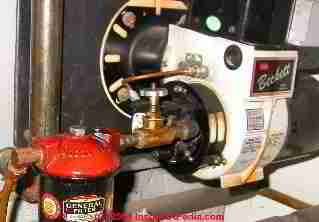 Why do we need an Oil Filter at Oil Burner?
Why do we need an Oil Filter at Oil Burner?
This oil burner fuel piping article series describes defects in heating oil piping, filters, safety valves, and oil tank fill and vent piping. All of these oil storage tank and piping installation defects can easily be found by visual inspection.
[Click to enlarge any image]
Photo at left: the red-capped heating oil filter is installed between the oil burner and the incoming single oil line. In this particular installation the oil safety valve (OSV) is on the "wrong side" of the heating oil filter.
While the valve can provide its fire-safety function in this position, this location makes servicing the oil filter (changing the cartridge) more difficult for the service technician.
To open this oil filter cartridge the heating service tech will have to find the heating oil tank where s/he will hope to find a second shut-off valve on the oil line to permit opening the filter cartridge without spilling oil all over the floor. A better location for the OSV would have been on the left hand or inlet side of the oil filter cartridge cap.
Beyond the costly problem of leaky oil piping, this document lists other important safety or oil-fired equipment operational defects in home and light commercial heating oil storage and piping systems.
Modern heating oil quality varies depending on the oil fields from which the crude oil was refined. In much of North America a significant portion of heating oil comes from Venezuelan crude which produces a more tarry product than product from the Arabian oil fields.
A shift to alternative oil sources began in the 1970's oil crisis. A result is that oil fired heating equipment that had worked fine for decades with no oil filter installed began failing due to oil fuel unit (oil pump) strainer clogging and oil burner nozzle clogging.
As a result, today all oil-fired heating equipment such as home heating boilers, furnaces and water heaters should have an oil filter installed.
Best Oil Filter Location
Sometimes the oil filter is installed at the oil storage tank outlet but the most common and recommended installation location is shown in our photographs at page top and above: the oil filter is installed close to the oil burner where it is easily accessible for service and where it filters oil immediately before the heating oil enters the oil burner assembly.
Location of Fire Safety Controls at the Oil Filter
The best place for the fusible link oil valve (Fire-o-Matic Safety Valve™ for example) is on the oil supply line just before the inlet to the oil filter canister (red arrow, below left), not between the canister and the oil burner as shown at below right (orange arrow).
This allows the service tech to shut off oil just before the filter canister in order to open the canister and change the oil filter cartridge.
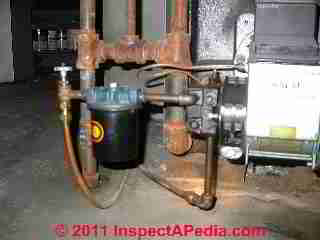
With the shutoff valve between the filter canister and the oil burner (below), changing the oil filter in the canister will require the service tech to go to the more distant oil tank to find and close a valve in that location (if one is even present).
11 May 2015 NHFireBear said:
Regarding "the best location of an oil filter", NFPA 31 (2011): 7.5.8, for indoor tanks up to 330 gallons, requires that a thermally activated shutoff valve be placed inline as close as practical to the outlet from a tank and that a proper filter or screen be installed downstream and WITHIN SIX INCHES of the required thermally actuated valve. If it's required in the code, it doesn't have to "the best" - it just has to comply with the code.
Many oil heat technicians sensibly want to install a fusible-link oil supply line valve at the oil burner, not only because this makes servicing the oil burner easier but because it also recognizes that the most-likely location of a fire is at the oil burner rather than possibly at a more distant oil storage tank.
Details about the proper location for OSVs are
Watch out: do not install an additional OSV on the return line of a 2-line oil piping system. Use a check valve instead.
See FIRE SAFETY for OSVs on 2-LINE OIL PIPING SYSTEMS and
also TWO LINE OIL PIPING VALVE & CHECK VALVE
Bad, Dangerous, or Stupid Locations for Heating Oil Filters
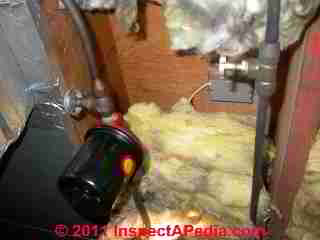
- Hidden oil filter locations that may be missed by the heating service technician
- Hard to access oil filter locations such as the stupid ceiling installation shown in our photo at left - just imagine spilling heating oil in your face as you try to carefully drop the oil filter canister base to change the filter.
Notice in our photo at above left that there is no fusible link oil shutoff valve installed on the oil return line exiting at the bottom of the fuel unit. A second valve in this location is a fire hazard.
Use a check valve on the return line instead. Details about this hazard are
Details about the selection, use, and installation of fusible link oil line safety valves are found
at OIL SUPPLY LINE SAFETY VALVES, OSVs.
Remote oil filter locations such as at the bottom of the oil tank located across the basement or in another room. Anything that makes the job more difficult for the heating service technician increases the chances of this important oil heat maintenance detail being ignored or delayed.
Make sure that your oil canister installation is not leaking oil nor air
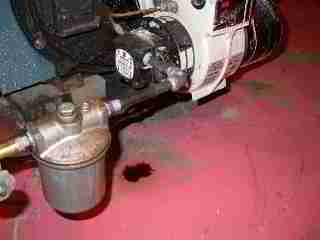 Notice that there's a heating oil leak below the connection to the filter outlet? This leak will suck air into the oil burner when it's running, leading to improper and possibly unsafe operation, risking a puffback.
Notice that there's a heating oil leak below the connection to the filter outlet? This leak will suck air into the oil burner when it's running, leading to improper and possibly unsafe operation, risking a puffback.
After any service procedure that disturbs oil line, filter, or burner oil piping fittings we recommend checking for evidence of oil leaks again after the system has been in use for a day or so, because slow leaks and small leaks in the oil piping system may not show up immediately.
As we report and illustrate in detail just below and as we also cite at at
at OIL SUPPLY LINE PIPING LEAKS, oil leaks anywhere in the oil piping and filter system may be hazardous.
Keep in mind that an oil leak out is an air leak in to the oil piping system as well, leading to improper oil burner operation, a dangerous puff-back, or loss of heat in the building.
Common Heating Oil Leak Points at the Heating Oil Filter
Details of where leaks are found at heating oil filter canisters & their fittings are now
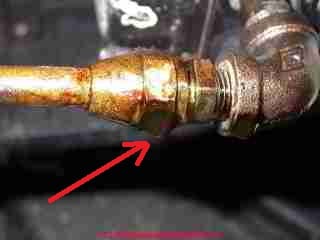 Our photo at left shows a pretty severe oil line leak that seems to be coming from the oil safety valve just ahead of the oil filter. We discuss this leak and other heating oil piping leaks in detail
Our photo at left shows a pretty severe oil line leak that seems to be coming from the oil safety valve just ahead of the oil filter. We discuss this leak and other heating oil piping leaks in detail
at OIL SUPPLY LINE PIPING LEAKS.
After any service procedure that disturbs oil line, filter, or burner oil piping fittings we recommend checking for evidence of oil leaks again after the system has been in use.
Oil piping leak at the copper piping flare to iron piping connection.
As we explained earlier, oil leaks anywhere in the oil piping and filter system may be hazardous. That's because even though the absolute amount of oil that drips out may be trivial, an oil leak out is an air leak in to the oil piping system as well.
Air may be drawn into the oil line when the fuel unit is pumping leading to improper oil burner operation, a dangerous puff-back, or loss of heat in the building.
Where Do We Usually Find Leaks at the Heating Oil Filter Canister Assembly?
Here are more illustrations of places where we often find leaks at heating oil filters: at the canister air bleed screw (not tightened, stripped threads, or failure to install a fresh gasket), at the canister top center bolt (same), and at the joint between the oil filter canister lid and base.
The oil filter assembly shown in the photos below was in deed leaking.
But it took a bit of work to find out exactly where the problem was.
Because oil flows from a leak anywhere on the canister top down the canister sides, you can be fooled about exactly where the heating oil leak is occurring. That's why an expert cleans and dries all of the surfaces meticulously. That makes watching for leaks easy.
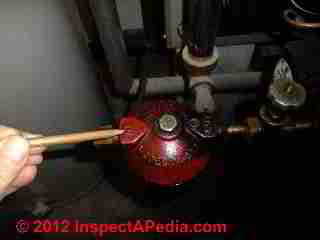
We examined the connections at the inlet side of the oil canister, the flare itself and the IPT threaded fitting entering the canister lid (above left). We examined the filter mounting bolt at the center of the canister lid (below).
Other tricks for finding an oil leak include using tracer powders on the cleaned surface, pressure tests, and even a paper towel on the floor below suspected drip points.
Next we examined the air bleed screw (below ) - ultimately we found both the center top bolt loose and the air bleed screw loose - the heating service tech had just forgotten to check & tighten them.
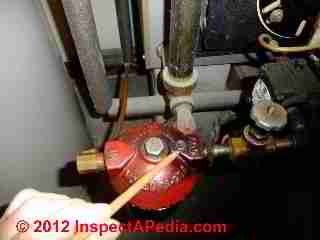
Below we indicate where you will often find wet heating oil - in the gap between the canister lid and canister base. But this is a confusing "wet oil" location. It could be wet in this spot for the following reasons:
- The service tech did not adequately wipe everything clean after s/he installed the new oil canister. This is especially true if air is bled from the small bleeder screw (above left) allowing oil to run over the top of the assembly where it enters the gap at above right.
- There is a leak at any point high on the oil canister assembly lid, including heating oil leaks at all three of the leak points in our first photo: the filter canister input side threaded fitting, the center mounting bolt, or the air bleeder screw.
- There is a bad gasket (old, nicked, broken, too small, or even forgotten) between the oil filter canister lid and canister base
- The oil canister mounting center bolt was left too loose.
Below at Frequently-Asked Questions (FAQs) about Heating Oil Filters on Boilers, Furnaces, Water Heaters we describe these oil filter leak points and how they occur in still more detail.
How to Change a Heating Oil Filter
 The oil filter cartridge should be changed during oil heating equipment annual cleaning, service, and tune-up. You should not have to change oil filter cartridges more often.
The oil filter cartridge should be changed during oil heating equipment annual cleaning, service, and tune-up. You should not have to change oil filter cartridges more often.
If the cartridge clogs and leads to service calls or heat loss between annual service calls then we suspect the oil tank is contaminated with water or sludge - problems that need to be corrected at the oil tank.
Details of a step by step procedure for changing the heating oil filter are now
at OIL FILTER CHANGE STEPS The procedure for changing the oil filter cartridge is simple, but if it's performed improperly you could be left with no heat.
Installing Duplexed Parallel Oil Filter Canisters - A Pair of Oil Filters Handles Oil Tank Sludge
In some difficult cases we found that we could not make it from one annual service call to the next without debris clogging in the oil filter and canister.
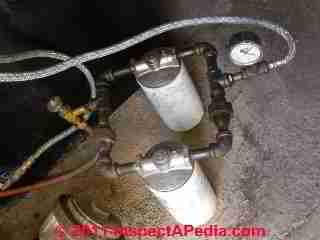 A solution that was far less costly than changing out the sound but sludgy indoor oil storage tank was the installation of duplexed oil filter canister cartridges.
A solution that was far less costly than changing out the sound but sludgy indoor oil storage tank was the installation of duplexed oil filter canister cartridges.
As shown in our photo at left, we installed the filter canisters side by side and routed piping so that they operated in parallel, not in series. (In series the first filter clogs and shuts down the system and the second filter is not helping.)
The copper oil line feeds a fusible-link oil valve shown at the left side of our photo. The oil piping then feeds a tee that in turn connects to two high-capacity oil filter canisters (center of the photo).
The outlets of each oil filter canister feed back into a common line that exits through a second tee, passes by an oil pressure (vacuum) gauge, and then connects by a flexible line to the oil burner inlet port.
Once installing this system we had no more heat outages due to oil filter clogging between annual service calls.
Watch out: generally it's preferable to remove sludge from an oil tank rather than add oil filters. In this case we had our oil company service technician check the indoor oil storage tank soundness before we elected to install the duplex oil filter system shown here. Had the tank not been sound it would have had to be replaced.
See OIL TANK LEAK TEST METHODS
See OIL TANK SLUDGE for details about methods for correcting this problem.
Where & Why Leaks Occur at Heating Oil Filters - & How to Fix Heating Oil Filter Leaks
 Watch out: leaks in heating oil appliance piping or filters can be much more serious than just a drip spot on the floor.
Watch out: leaks in heating oil appliance piping or filters can be much more serious than just a drip spot on the floor.
The same leak that allows oil to drip out of the oil filter or piping connections allows air to be drawn into the system when the oil fuel unit (oil pump for the water heater, oil fired boiler or furnace) is running.
That air leak into the system results in improper oil burner operation, soot clogging, and even a loud bang at oil burner start-up or worse, a dangerous puffback. Detailed explanation of why an oil line leak causes a bang or puffback at the oil burner, and loss of heat is
at OIL LINE LEAKS - Oil Line leaks found
Reader Question: Why is my oil filter canister leaking oil - apparently from the bottom of the unit?
I recently replaced my oil filter (I actually replaced the entire oil canister with a new oil canister that included the filter already inside of it). The burner is working properly, the flame is on,and I'm getting hot water.
The problem is that I seem to have a small/minor leak from the oil canister itself. Oil is dripping from the canister (I think it's leaking from the bottom of the canister). I've checked all the fittings to make sure they're not loose. They're all tight, as are all the connections in and out of the oil canister.
Do you know why the oil canister could be leaking? Was I supposed to tighten the bolt/screw that's on the bottom of the canister (underneath the filter) as well? I assumed the oil canister came ready to install and that I wouldn't have to adjust the top or bottom bolts on the canister.
Any idea why the oil canister is leaking oil (from the bottom)? - Thanks, Ed Salva
Thanks to Mr. Salva for the Mitco oil filter canister photo (above left). Mr. Salva's photo illustrates an important detail: place a suitable container below the oil filter canister to catch any spills before you attempt to service the unit.
Reply: Check for missing or damaged fiber washers and o-ring as well as leaky flare fittings
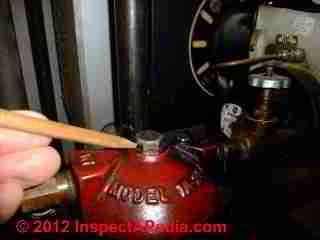 Ed,
The oil filter canister does not normally leak through its bottom as that is solid steel on the models I am familiar with. Only an older canister with rust perforation would leak there.
Ed,
The oil filter canister does not normally leak through its bottom as that is solid steel on the models I am familiar with. Only an older canister with rust perforation would leak there.
The oil filter canister is installed with a bolt that goes down through the red top and taps into threads in the bottom of the canister.
In our photo (left) my pencil points to the top bolt that secures the oil filter canister base to the top.
There are two seals: a (usually red) fiber washer that mounts under the bolt head and an O-ring seal between the lip of the canister and its top.
There is also a tiny fiber washer underneath a small air bleeder screw found on the top of the oil filter canister.
at OIL BURNER FUEL UNIT AIR BLEED PROCEDURE you can see a closeup of this oil filter air bleed outlet on another oil filter canister brand, and there you'll see the fiber washer too.
If any of those three seals were omitted or damaged, that would make an oil leak that might begin at the edges of the canister or even its top but then run down the device and appear to be dripping off its bottom.
Tightening the bolt won't fix it.
Where to leaks occur at heating oil filter canister assemblies?
Another common leak point at oil filter cartridges is the joint between the oil filter canister base and the red oil filter assembly top.
If a hasty service tech (or you) forgot to tighten the top bolt the result will be an oil leak and improper oil burner operation.
Common leak points at or close to a heating oil filter assembly include:
- Leaks between the canister base top edge and the canister top, due to an old, faulty, gasket or due to a loose assembly top bolt
- Leaks at the oil filter air bleeder screw due to a faulty or missing gasket or due to a loose bleeder screw
- Leaks at the oil filter fittings entering and leaving the canister assembly, particularly at flare fittings that may have been wiggled and jiggled around by a heavy-handed service person who used just one wrench to loosen or tighten the top bolt.
Use two wrenches, one on the bolt and one on the rectangular inlet or outlet casting to avoid twisting oil piping and causing still more oil piping leaks.
If you never have opened the oil filter canister, I'd shut off oil at the fire-o-matic valve between canister and oil tank, turn off the oil burner of course, and open the canister - to be sure it contains a filter and to be sure that all of the gaskets and o-rings are in place and un-damaged.
At OIL TANK PIPING & PIPING DEFECTS you'll find more about oil piping and filter leaks, photos, and suggestions.
In OIL FILTERS on HEATING EQUIPMENT you will see photos of the filter canister type I'm discussing.
Send me a photo of your filter/canister as it may be a different brand or model than what I describe above.
Continued from Ed:
Thanks for the quick response. I have to say that this website has a TON of valuable information!
I'm at work now but when I get home I'll try to attach a picture of the oil filter. It actually looks very similar to the one in the picture on this website (the picture under "HEATING OIL FILTER - NONE - No Oil Filter Installed on Oil Fired Equipment"). The silver one.
I replace the filter yearly on my burner. This year, I decided to change the whole canister as I felt it needed to be changed (it's the original canister that was installed 8 years ago). Then I ran into the problem of oil leaking from the oil canister.
When I first replaced the oil canister a couple of days ago, that's when I noticed the oil leak. I thought immediately that I had bought a defective oil canister. So I decided to take it apart. Surprisingly, everything in the canister was intact (filter, o-ring, etc). Then I went back to the hardware store and purchased ANOTHER oil canister and installed this new one. Same problem, oil leak from bottom of oil canister.
That's when I started researching and came across this site and posted my question.
Can the nozzle have anything to do with this leak? It's not a major leak, just a few ounces per day. Nonetheless, any oil leak is not good and I want to stop the leakage if I can on my own.
When I got home last night, I took some pictures of the oil canister.
I don't know how to attach photos to the comments section here, thus I can email them if interested.
I also noticed that the small leaks seems to be coming from the 'OUT' part of the oil canister. I checked to make sure the fitting was tight, and it was. I will take the brass fittings off and put on pipe joint compound on the pipe threads. Then I'll reattach the brass fittings to the oil canister/pipes and make sure that the lines are air tight. Hopefully, this will stop the leak.
I don't want to make them to tight where I risk stripping the threads or the brass fittings.
Continued from DF:
Ed mail photos using the CONTACT link found at top, left, or bottom of our web article pages.
Try using blue LeakLok™ thread sealing compound (available at auto supply stores, plumbing and heating suppliers, or from Argo [1]) on thoroughly cleaned threads at the outlet fitting on your canister. I'd clean the reads carefully on both mating surfaces and then use that product or a similar one rated for use on piping systems for heating oil.
I agree with taking care not to strip threads. Using a sealant can help avoid trying to fix a leak just by tightening. Also FYI iron pipe threaded fittings are tapered so that the fitting gets tighter as it is turned inwards.
But that means that every time you disassemble and re-use a fitting it has to be turned in further than before to get tight. In turn that means on some devices a fitting can bottom out or reach end of threads without being satisfactorily tight. That's why plumbers often will not re-use brass-to-steel fittings such as the adapter on your filter canister inlet and outlet sides. If you disassemble and reassemble, it's cheap to use a new fitting plus leak-lok.
Beware: an oil leak OUT is also an air leak IN under varying operating conditions and an air-leak in causes burner operating problems, sooting, and even risks a puffback.
If your heating appliance fuel is LP gas or natural gas, see GAS PIPING, VALVES, CONTROLS.
...
Reader Comments, Questions & Answers About The Article Above
Below you will find questions and answers previously posted on this page at its page bottom reader comment box.
Reader Q&A - also see RECOMMENDED ARTICLES & FAQs
On 2020-11-06 by (mod) - prefers oil filter at the oil tank
Thanks for the helpful comments, Bill.
On 2020-11-06 by Bill Limoges
I would like to take issue with the location of the oil filter.
I've been a heating contractor for over 40 years, and I can tell you that the vast majority of the oil filters are located at the tank, and for a very good reason- it protects the oil line coming from the tank to the burner. The only time I ever install an oil filter at the burner, or away from the tank is when there is an accessibility issue.
On 2020-01-12 - by (mod) - find the furnace model number
Dawn
Look for a data tag giving that information, often inside the front access cover or after removing that cover, on one of the sides or other surfaces in the furnaace;
On newer equipment the data tag is usually on the heater's exterior, on top, front, or sides.
On 2020-01-12 by Dawn Casey
Where do I find the model number on my oil furnace
On 2018-09-22 by (mod) - oil filters are cheap
JD The oil filter is very inexpensive - (less than $2.00) - it my view it makes sense to replace it as part of annual oil burner service. So, in sum, once a year.
On 2018-09-22 by J daley
We use our oil furnace half the time between Oct & May, because we also have a pellet stove. We have a fairly new fiberglass oil tank. How often should we change the heating oil filter? Is there a time frame or does it depend on how many gallons of heating oil we use?
Thanks!
On 2018-07-09 by Paul
Is there any code that says you can’t put a filter at the boiler and one at the other end of the basement on the oil tank that the service guy is likely to mis when servicing the unit?
On 2018-05-02 by (mod) - oil tank fill stirs sludge, risks loss of heat and burner shut-down
Charlie
Sometimes when we refill an older oil storage tank, particularly if it's an older tank or if the tag has accumulated sludge or water, then the delivery of oil canister that debris or water.
Then when you try to run your heating system the debris gets pushed into and clogs the filter or the oil pump screen or the oil burner nozzle. You need a service call to correct those conditions.
Of course if you ran out of oil completely then the problem would more likely be air in the lines.
On 2018-05-01 by charlie
Just put 100 gallons of oil in tank now my furnace shut down it is a energy kinetics system 2000 got some lights on could it be oil filtrr
On 2017-10-26 by Cynthia
I have an outdoor oil tank that never had an oil filter installed. Last winter the nozzle continually clogged and on & off I had no heat. I need to have one installed but I'd like some kind of ballpark of what that standard charge may be.
The company I called first quoted me $600.00, I'm wondering if that may be a standard approximate amount.
Is this something I could do on my own, I'm a little handy, or should I have a professional handle this.
I have changed my nozzle out, probably about 6 times last season, so I've got that down.
Any answers anyone could provide would be much appreciated.
On 2017-08-14 by Susan
My oil filter canister leaked? How common is that? My repair guy did not find the leak the first two times he came to check and, after the leak resulted in a mess to clean up, he claimed he had never seen a leak like that in the 40 years he has been doing heating work. Is this really so rare that a repair expert would not find it when looking for a leak?
Thank you
Question: best height of oil filter above the floor
(Nov 18, 2012) Frank F. said:
How far off the floor should the bottom of a new oil filter be?
Reply:
Frank,
The oil filter needs enough room under it's canister body to slide in a pan to catch any drips or spills and to drop down the canister to remove it to change the oil filter. 3" or more should be ok.
You don't need distance equal to the whole canister as pulling the center bolt will allow the canister to be removed in the space I described.
Question: white,chalky coating all over the oil filter
(Feb 15, 2013) Emma C. said:
We recently( 4 weeks ago) had a new oil filter fitted to our outside oil tank as the old one had developed a very slow leak.
I went outside today to check the oil level and noticed a white,chalky coating all over the filter which rubbed off on my hand and smelled very faintly of oil - is this normal or is there something wrong with the filter?
The filter is made of what appears to be aluminium with a burnished/bumpy/matt surface - am worried in case the plumber has used a filter that cannot withstand winter temp outside (we live in Northern Ireland!)Many thanks for any advice you can provide!
Reply:
Ask your heating service tech for an opinion; sometimes the white crud tells us there's a leak or a water contaminant.
Question:
(Feb 25, 2013) Robin A said:
You explain quite well, how to vent the system after conducting the oil filter maintenance routine.
However, as you stated. "If your heating oil tank is at a level higher than that of the filter itself this is an easy task".
Unfortunately for me, my dual lines run upwards from the supply tank, sort of halfway to the ceiling and then back down into the furnace supply filter. Can you tell me how to bleed this contraption properly?
My only idea is to air-load the supply tank to a slightly positive pressure by capping the vent and applying about 1/2 psig air at the fill connection and then bleeding as you described. Please help.
Reply:
I would not pressurize the oil tank. Rather use the fuel unit (turned on) to bleed the system.
Question:
(Apr 21, 2014) jc said:
new oil filter is differant than old
Reply:
JC if the oil filter fits into the cartridge and seals properly it should be ok. Be SURE to check the oil filter part number and description to assure that it is intended to fit inside the oil filter canister on your system.
Otherwise it won't do its job and you'll be headed for a No-Heat service call.
Question: busted Fire-O-Matic OSV - handle and shaft turn together
(Aug 30, 2014) Jim said:
When I try to re-open my Fire-o-Matic OSV after a filter change, the stem turns with handle so there is no relative motion.
I was able to pull up on the handle manually and bring the stem upward against its spring tension, whereupon I was able to grasp the stem with a very small set of needle nose pliers, but that only let me turn the knob down a few turns until it contacted the pliers.
So the valve is "partially" open, but not fully open. I'm prepared to replace the valve in its entirety if necessary, but do you have any other suggestions as to how I can get my current valve fully open? Thanks.
Reply:
Jim it sounds as if the valve needs to be replaced.
But first, be sure you're turning in the right direction - it's not the ususal.
Comment: Mitco Oil filter cartridge canister leaks through bottom bolt
Rep(Aug 31, 2014) Anonymous said:
Hi, In response to Ed and his filter leaking through the bottom bolt.
I too, unfortunately, have the Mitco oil filter and have nothing but problems with them leaking through the bottom bolt. I don't know why that bolt is there but it is a poor design and I wish my oil company didn't use themly:
Question: why am I getting air in my oil lines
(Oct 23, 2014) Chris said:
Hi all i have a question. I was wondering why i am getting air in my lines with no apparent leaks. I can bleed the lines and it runs a full cycle. Then it will not come on again cause of air in lines? Tank is full.
Reply:
Air leaks can be tough to find. I've traced them to pinholes an to dirt and once a small groove in the flare of a flare fitting.
Clearly there's a leak somewhere. I'd inspect the line and fittings carefully through the entire route for oil seepage - often we can find an air leak in by finding an oil leak out. A trained oil heat service technician will install a vacuum test gauge to see what's going on with the oil piping.
...
Continue reading at OIL FILTER CHANGE STEPS or select a topic from the closely-related articles below, or see the complete ARTICLE INDEX.
Or see these
Recommended Articles
- BOILER CONTROLS & SWITCHES - controls used on all brands of heating boilers and
- FURNACE CONTROLS & SWITCHES - controls used on all brands of heating furnaces
- OIL BURNER FUEL UNIT AIR BLEED PROCEDURE
- OIL BURNER MANUALS provides links to manuals for oil burners, controls, fuel units, etc.
- OIL BURNER NOISE SMOKE ODORS
- OIL FILTERS on HEATING EQUIPMENT
- OIL TANK PIPING & PIPING DEFECTS
- OIL TANK SPILL CLEANUP / PREVENTION
- PUFFBACKS, OIL BURNER
Suggested citation for this web page
OIL FILTERS on HEATING EQUIPMENT at InspectApedia.com - online encyclopedia of building & environmental inspection, testing, diagnosis, repair, & problem prevention advice.
Or see this
INDEX to RELATED ARTICLES: ARTICLE INDEX to HEATING OIL, OIL BURNERS, OIL FIRED HEATERS, OIL TANKS
Or use the SEARCH BOX found below to Ask a Question or Search InspectApedia
Ask a Question or Search InspectApedia
Try the search box just below, or if you prefer, post a question or comment in the Comments box below and we will respond promptly.
Search the InspectApedia website
Note: appearance of your Comment below may be delayed: if your comment contains an image, photograph, web link, or text that looks to the software as if it might be a web link, your posting will appear after it has been approved by a moderator. Apologies for the delay.
Only one image can be added per comment but you can post as many comments, and therefore images, as you like.
You will not receive a notification when a response to your question has been posted.
Please bookmark this page to make it easy for you to check back for our response.
IF above you see "Comment Form is loading comments..." then COMMENT BOX - countable.ca / bawkbox.com IS NOT WORKING.
In any case you are welcome to send an email directly to us at InspectApedia.com at editor@inspectApedia.com
We'll reply to you directly. Please help us help you by noting, in your email, the URL of the InspectApedia page where you wanted to comment.
Citations & References
In addition to any citations in the article above, a full list is available on request.
- Audels Oil Burner Guide, Installation, Servicing, Repairing, Frank D. Graham, 1940's edition (obsolete). Updated versions of this guide are available in various editions, 1947, 1950, 1955, 1958, 1959, 1962, 1965, 1967, and at prices from around $3.00 to nearly $70.00 - useful for simple, clear, but not current, explanation of how heating equipment works. The original retail price was $1.00.
- Dave Ferris - M&S Environmental Systems, Dutchess County, New York. Mr. Ferris was an HVAC expert. Personal communication to DJF 1987. Remove the firematic or fusible oil supply line valve on return oil-line side - in case of fire if this one closes first the pump continues to run, blows its seal, and sprays oil all over the fire. Proper installation is to have a fusible link valve only on the supply side, and to install a check valve on the return line to prevent back-siphonage from the tank.
- "HUD Regulation for Manufactured Homes; Requirement that Heat-Tape not include a GFCI [ copy on file as /plumbing/GFCI_Heat_Tapes_HUD_CPSC_Letter1994.pdf ] - ", Meeting Log, US CPSC, HUD, Dennis McCoskrie, ESEE, 2/14/1994
- [1] LeakLok™ blue thread sealant compound is available from Argo, Inc., 2610 Commerce Way, Vista CA 92083, tel: 800-854-1015. Quoting from the company's product literature:
Leak Lock Blue Joint Sealing Compound 1.3 oz. tube Soft setting joint compound that seals threaded joints, gasket surfaces and mating surfaces. Resin-based brushable paste which remains permanently flexible, internal surfaces and fills voids. Excellent for use on metal and plastic materials subject to extreme vibrations. - Our recommended books about building & mechanical systems design, inspection, problem diagnosis, and repair, and about indoor environment and IAQ testing, diagnosis, and cleanup are at the InspectAPedia Bookstore. Also see our Book Reviews - InspectAPedia.
- In addition to citations & references found in this article, see the research citations given at the end of the related articles found at our suggested
CONTINUE READING or RECOMMENDED ARTICLES.
- Carson, Dunlop & Associates Ltd., 120 Carlton Street Suite 407, Toronto ON M5A 4K2. Tel: (416) 964-9415 1-800-268-7070 Email: info@carsondunlop.com. Alan Carson is a past president of ASHI, the American Society of Home Inspectors.
Thanks to Alan Carson and Bob Dunlop, for permission for InspectAPedia to use text excerpts from The HOME REFERENCE BOOK - the Encyclopedia of Homes and to use illustrations from The ILLUSTRATED HOME .
Carson Dunlop Associates provides extensive home inspection education and report writing material. In gratitude we provide links to tsome Carson Dunlop Associates products and services.


